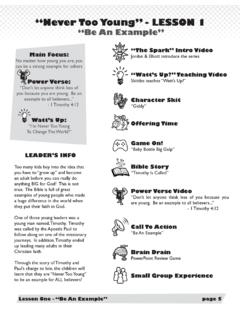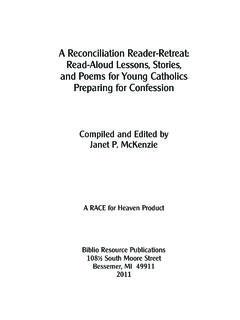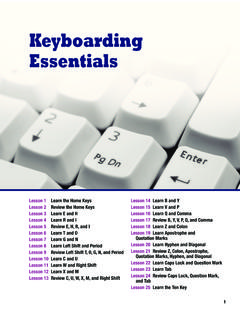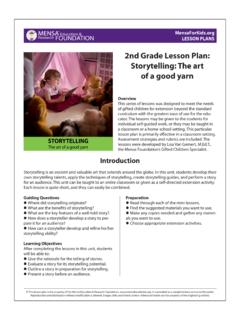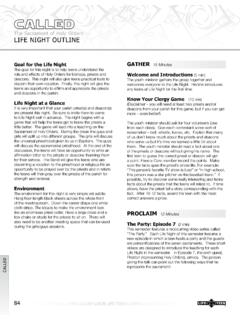Transcription of Boundaries: You Have Rights! - VIRTUS® Online
1 Protecting God s Children Teaching Safety Empowering God s Children Instructions for Lesson Leaders Empowering God s Children Copyright 2004-2018 by National Catholic Services, LLC. All rights reserved. Page 1 of 8 Lesson 3 for Grades 6, 7 & 8 Boundaries: You Have Rights! Background for Lesson Leaders: Before beginning this session, the Lesson Leader should read the Teaching Boundary and Safety Guide, as it gives a wealth of information regarding boundaries and how to address them. Remember that children of this age are dealing with enormous peer pressure while trying to understand their independent role in the world apart from their families. It is not always cool to say that you must tell someone if you are touched or approached (in person, or Online ) in an inappropriate or sexual way.
2 Situations of this nature may involve immense shame, guilt, threats, etc., for the youth. So, do your best to stress the importance of good communication while speaking to the adolescent in a way that has him / her actually hear you, rather than ignore you. It will be important for the adult to stress healthy behavior and boundaries, and the right thing to do when discussing boundaries to this age group. These exercises are intended to empower young people to begin to think about safety issues and to be their parents partners in making sure the child has the tools needed to resist the overtures of a potential child molester or an adult with poor intentions. PRINCIPLE Youth must understand they have a right to be safe, and they are allowed to create boundaries to protect themselves in situations where they feel uncomfortable, or where they could be harmed.
3 CATECHISM / SCRIPTURE Freedom is exercised in relationships between human beings. Every human person, created in the image of God, has the natural right to be recognized as a free and responsible being. All owe to each other this duty of respect. The right to the exercise of freedom, especially in moral and religious matters, is an inalienable requirement of the dignity of the human person. This right must be recognized and protected by civil authority within the limits of the common good and public order. Catechism of the Catholic Church, #1738 (1997) OBJECTIVES Through this lesson, the adult lesson leader reinforces the parent s message about boundaries. After Lesson 3, children should be better able to: Identify and define various types of boundaries Begin to set their own boundaries and communicate them to others Honor appropriate boundaries in different types of relationships Technology Component: Understand boundaries can apply for Online activities, too This age group: Dealing with pre-adolescents and adolescents key concept is transition The middle school child is experiencing a period of rapid growth.
4 The emergence of interest in the opposite sex is occurring. He / she is often concerned about physical change, body size, skin quality and hair length. Body image is very important to this age as he / she complains of being either too physically mature or immature and may also complain that they do not have enough privacy. The peer group plays an import role in shaping attitudes and interest. Caregivers need to regularly assure youngsters that changes are normal, though the rate of change varies from person to person. Lesson leaders must carefully listen to children and observe what is happening in their lives. Let young people be themselves. Let them explore their self-expression; but, know who they are with and what they are doing, and remind them of the importance of protecting themselves during this dynamic time in their lives. During this time, children are completely self-absorbed, and many are naturally less communicative than at other periods during their development.
5 This is the point that more trust will be given to the youth to evaluate safe and unsafe situations when they are not in the care of their parents. Lesson 3 for Grades 6, 7 & 8 Boundaries: You Have Rights! (cont.) Empowering God s Children Copyright 2004-2018 by National Catholic Services, LLC. All rights reserved. Page 2 of 8 ACTIVITY OPTION #1: Play the (optional) introductory video as an icebreaker The introductory video for children and youth in this age range is designed to open a simple discussion about personal boundary safety. The video is brief and is not intended to be a substitute for the lesson itself. It's merely an introduction designed to "break the ice" and assist the transition of completing the interactive Lesson Activity options. If the video is shown as an optional activity, please use in conjunction with one of the additional activity options, because discussion and practice are the critical components needed to teach children and youth how to protect themselves.
6 They learn best by "doing"; not just listening. ACTIVITY OPTION #2: Review and discuss key vocabulary words Rules a prescribed guide for conduct or action. We follow the rules to make sure we are safe just like how we have a seatbelt rule to keep us safe in the car, or the safety rules before we cross the street. [For example, teach the child a simple rule for what to do if someone tries to touch him / her in an unsafe way, which is to say No! , try to get away, and tell an adult as soon as possible.] Limits the point or edge beyond which something cannot go. The furthest edge of something. Rights We are all born free and equal, and have certain rights that are automatically ours. Everyone is entitled to these rights, and they should not be taken away from us. For example, teach children, you have a right to be safe, and your body belongs to you!
7 Boundaries the limits that define one person as separate from another or from others. There are boundaries you can see (like a fence around a yard) and boundaries you can t see with your eyes (like the comfort zone around us that we call our personal space ). Boundaries vary depending on the relationship with the other person. For example, a boundary between a child and a grandparent is different than the boundary between a child and a teacher or coach. Saying No to say no means to refuse, deny, reject or express disapproval of. This word is used to express a boundary and communicate that you do not want something to happen or continue. [Let children know It s OK to say No to an adult if they make you feel scared or uncomfortable, or if they touch your private body parts.] Secret something kept hidden, never told or unexplained.
8 Secrets exclude others and have potential to harm, sometimes causing the person involved to feel frightened or uncomfortable. [For example, let children know that there are no secrets when it comes to personal and physical safety. Tell children that it s wrong for an adult or another child to ask a child to keep a secret about safety especially unsafe touches because that s a way for people to get hurt. If an individual tries to make a child keep a secret or makes him / her feel frightened, the child must know to communicate this information right away to a parent or caring adult and be reassured that the child will be protected regardless of threats or seeming consequences of telling .] ACTIVITY OPTION #3: Discussion Discovering the boundaries in your life Activity: The purpose of this activity is to create scenarios for youth that will give them ideas about boundaries and limits, and how both are an important part of our daily lives.
9 You ll discuss how rules establish boundaries, how sometimes we people infringe on our boundaries, and how we can create them for ourselves. Discussion: Step 1: Begin the conversation about boundaries by asking if they know what a boundary is, and have them explain it from their perspective. Step 2: Then, begin to create scenarios by asking questions about some of the rules they have at home. For example: What are your family rules regarding when your homework must be completed? Are there other activities that aren t allowed until your homework has been completed? For how long, and how late are you permitted to be on the phone? What are your family s rules regarding the Internet? What are your family s rules regarding gaming or video games? Lesson 3 for Grades 6, 7 & 8 Boundaries: You Have Rights! (cont.) Empowering God s Children Copyright 2004-2018 by National Catholic Services, LLC.
10 All rights reserved. Page 3 of 8 Does your family limit who can come into your room and when they are allowed to be in your room? Do you expect your best friend to sit next to you at lunch every day? Do you want your parents to pretend that they don t know you when you are together at a party or at the mall? Do you wear any type of seatbelt when you re in the car? Can you explain why you moved the chairs, sat closer to some people and away from others, left empty chairs between you and others, etc. when we started this class? Explain: Each of these rules that we just talked about establishes a boundary. Everyone has them, including adults. Like the examples just discussed, some are rules that are given to us by others like our parents, teachers or coaches. Step 3: Explain that sometimes we get to choose our own boundaries, and ask the children if they can think of any ways that they have created boundaries or rules for the people in their lives.


